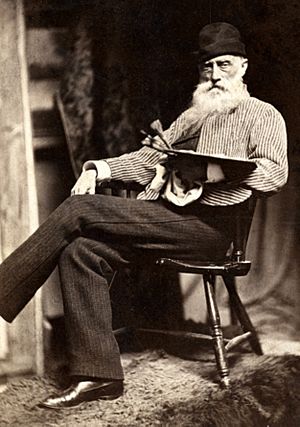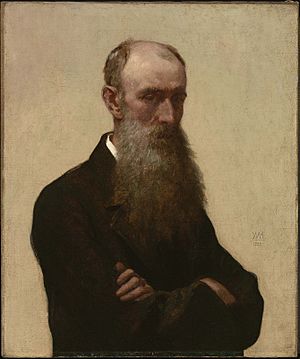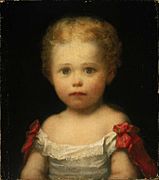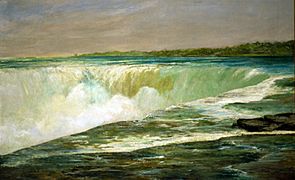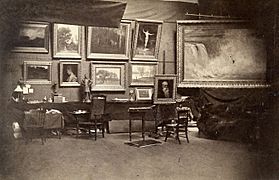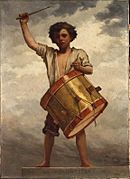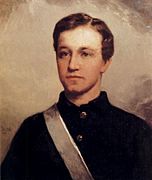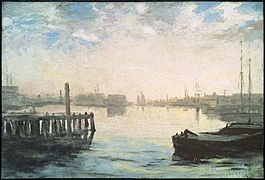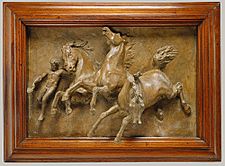William Morris Hunt facts for kids
William Morris Hunt (March 31, 1824 – September 8, 1879) was an American painter. He came from the important Hunt family of Vermont. William trained in Paris with the realist painter Jean-François Millet. He also studied with Millet at the Barbizon artists’ group. When he returned to America, Hunt started a similar art group. He became a top portrait and landscape painter in Boston. He also worked as a lithographer (making prints) and a sculptor. Many of his artworks were lost in the Great Boston Fire of 1872. Other paintings, which were murals on stone panels in the State Capitol at Albany, New York, were also lost because the stone fell apart.
Contents
Early Life and Artistic Journey
William Morris Hunt was born into a well-known family. His father's family, the Hunts of Vermont, were among the state's first settlers and owned a lot of land. His mother's family was also wealthy and important in Connecticut. William went to Harvard College but left during his third year. His father had not let him paint or draw. But after his father passed away, William's mother, Jane Leavitt Hunt, decided her children would get to study art. She even moved them to Europe so they could go to the best art schools.
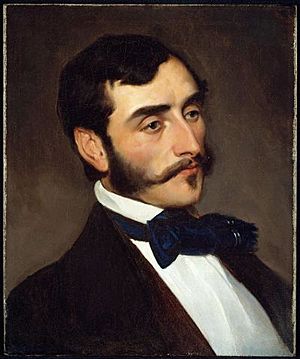
William's father, a Congressman, died in 1832 when William was eight. After this, his mother took him and his brothers to Switzerland, southern France, and Rome. William studied with Thomas Couture in Paris. He was very inspired by Jean-François Millet's painting The Sower at the 1851 Paris art show. This led him to be influenced by Millet. The Hunt family stayed in Europe for twelve years. For some of that time, William and his brother Richard Morris Hunt shared an apartment in Paris. William studied painting there. Historian David McCullough said that the training the brothers received in France helped them greatly in their work. William then spent two years learning from Millet in Barbizon before returning to the United States.
Influence of the Barbizon School
Spending time with Millet greatly influenced Hunt's art style and personality. His work became stronger and more serious. He was one of the biggest supporters of the Barbizon school in America. More than anyone else, he encouraged young American painters to study in Paris. Samuel Greene Wheeler Benjamin, an art writer, said that Hunt helped bring new art styles from Europe to America. He made artists understand how important good style was.
After leaving Paris, Hunt painted and used his family connections to start art schools. He opened schools in Newport, Rhode Island, Brattleboro, Vermont, the Faial Island in the Azores, and finally in Boston. In Boston, he became a very popular portrait painter.
Before his celebrated return to America in 1855, Hunt married Louise Dumaresq Perkins in Paris. She was the daughter of a Boston merchant and art supporter. Hunt married Ms. Perkins again in Boston in 1855, possibly for legal reasons. This second wedding took place at King's Chapel in Boston.
When he returned, Hunt painted some of his most beautiful artworks. These paintings reminded people of his time in France and Millet's influence. Examples include The Belated Kid and Girl at the Fountain. However, people mostly wanted portraits, and it became popular to have Hunt paint your picture. Some of his best portraits are of important people like William M. Evarts, Mrs Charles Francis Adams, and Senator Charles Sumner.
Later Works and Legacy
Many of Hunt's paintings and drawings were lost in the Great Boston Fire of 1872. He also owned many paintings by Millet, which were destroyed.
Later in his career, American landscapes became more common in his work. In the summer of 1878, the year before he passed away, Hunt painted many grand scenes of Niagara Falls. His later works also included "Bathers: Twice Painted" and "The Allegories." These were murals for the State Capitol in Albany, New York. Sadly, these murals are now lost because the stone panels they were painted on fell apart. His book, Talks about Art (1878), was very popular.
Hunt did not just paint with oil. He also worked as a lithographer and a sculptor. From 1850 to 1877, he was Boston's leading portrait and landscape painter. Many wealthy Boston families wanted him to paint them. Hunt is known for influencing artists like Winslow Homer, Childe Hassam, and John Joseph Enneking. Hunt's lively way of painting, which he learned from European art, started a new style of "oil sketching" that other artists continued.
Art historian G. W. Sheldon called Hunt "the greatest of Boston painters." He said that Hunt was a truly original artist. Some experts today are looking again at how much Hunt influenced other early New England artists. Hunt was a very important person in New England's art and society. He collected art himself and encouraged other Boston collectors to buy works by European artists like Millet and Monet.
Once, after an art show in Boston that included works by Millet, a Harvard professor wrote a negative review in a newspaper. Painter Hunt was upset and wrote a strong reply in The Boston Daily Advertiser. He wrote, "It is not our fault we inherit ignorance in art, but we are not obliged to advertise it."
In 1867, Hunt and his wife went to Paris for the opening of a big art exhibition. In his lectures and art classes, Hunt had many students, often from important Boston families. The famous philosopher William James studied with Hunt for a while before deciding to focus on writing. In 1871, Hunt was chosen to be an Associate Academician of the National Academy of Design.
Hunt's career was certainly helped by the lively intellectual scene in Boston. For example, at a lunch at his club in 1870, many important people were present. These included Ralph Waldo Emerson, James Russell Lowell, Henry Wadsworth Longfellow, and William James.
William Morris Hunt passed away at the Isles of Shoals, New Hampshire, in 1879. He had gone there to recover from a difficult time. He kept working and made his last drawing three days before he died. His friend, the poet Celia Thaxter, found his body.
His brother Richard Morris Hunt was a famous architect. Another brother, Leavitt Hunt, was a well-known photographer and lawyer. A fourth brother, Jonathan, was a doctor in Paris.
The William Morris Hunt Library at the Boston Museum of Fine Arts is named after him. Hunt was one of the people who helped start the museum's art school. After Hunt's death, his Harvard classmates and other Bostonians raised money to buy many of his paintings and give them to the Museum of Fine Arts.
Besides the Museum of Fine Arts, the Boston Athenaeum also has many of Hunt's works. Other museums that own his art include the Metropolitan Museum of Art in New York City, the Louvre Museum in Paris, the Musée d'Orsay in Paris, and the National Gallery of Art in Washington, D.C.
William Morris Hunt was buried at Prospect Hill cemetery in Brattleboro, Vermont, with his family. Twenty years after his death, his former student Helen M. Knowlton wrote a book about him called The Art-Life of William Morris Hunt.
William Morris Hunt and his wife, Louisa Dumaresq Perkins, had five children.
Gallery
-
Portrait of Morris Hunt, son of William Morris Hunt, 1857, Boston Museum of Fine Arts
-
Niagara Falls, 1878, one of his last paintings
-
The Drummer Boy, c. 1862, Museum of Fine Arts, Boston
See also
 In Spanish: William Morris Hunt para niños
In Spanish: William Morris Hunt para niños
- Richard Morris Hunt
- Leavitt Hunt
- Thaddeus Leavitt
- Jonathan Hunt (Vermont Representative)
- Jonathan Hunt (Vermont Lieutenant Governor)
- Jarvis Hunt


